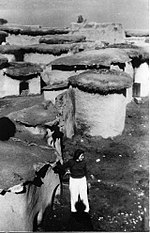Charge at Huj

The Charge at Huj (8 November 1917), (also known by the British as the Affair of Huj), was an engagement between forces of the British Empire' Egyptian Expeditionary Force (EEF) and the Ottoman Turkish Empire's, Yildirim Army Group during the Sinai and Palestine Campaign of the First World War. It took place during the Pursuit phase of the Southern Palestine Offensive which eventually captured Jerusalem a month later. The charge was carried out by units of the 5th Mounted Brigade, against a rearguard position of German, Austrian and Turkish artillery and infantry armed with machine guns. The charge was successful and the British captured the position, seventy prisoners, eleven pieces of artillery and four machine guns. However British casualties were heavy; of the 170 men taking part, twenty-six were killed and forty wounded. They also had 100 horses killed. The charge is claimed to be one of the last British cavalry charges and was immortalised in a watercolour painting by the noted British artist Lady Butler.
Excerpt from the Wikipedia article Charge at Huj (License: CC BY-SA 3.0, Authors, Images).Charge at Huj
Shaar HaNegev Regional Council
Geographical coordinates (GPS) Address Nearby Places Show on map
Geographical coordinates (GPS)
| Latitude | Longitude |
|---|---|
| N 31.509722222222 ° | E 34.6225 ° |
Address
Shaar HaNegev Regional Council
South District, Israel
Open on Google Maps









